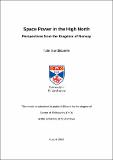Space power in the High North : perspectives from the kingdom of Norway
Abstract
Norway’s main impetus for developing national military satellite-based capability was the 1977 introduction of the EEZ, through which Norway became responsible for vast maritime areas in the High North. These capabilities also underpinned Norway’s intelligence mission that entailed monitoring Russian military activity, especially the Kola Bay-based Russian strategic forces in the vicinity of Norway. Norway developed niche technologies for military use predominantly based on civilian satellites, and ESA became an essential instrument as it enabled Norway to develop indigenous satellite-based services for the Norwegian Armed Forces. Norway in turn used this capability to reinforce its military relations with the United States and key allies within the NATO framework. Following the pivotal military space strategic review in 2014/2015, the Norwegian Armed Forces developed a function-oriented management structure and incorporated space as a new military domain. National security implications of space were finally incorporated into Norwegian space policy, and Norway has since developed a wide range of national space capabilities, all of which support the nation’s defence and security objectives.
This thesis examines how Norwegian military space activity fits into the nation’s overall defence and security policy and argues this activity and the associated national capability development has emerged as a strategic asset in Norwegian alliance policy. This activity reflects upon relations between national policymakers and practitioners, and has contributed to obscure the notion of civil-military separation in Norway. The activity also demonstrates the existence of two unofficial space doctrines in Norway. One focuses on intelligence and the other on force enhancement. The 2020 appointment of the Norwegian Intelligence Service as Norway’s military space authority demonstrates the value of space for intelligence activities supersedes other uses of the domain. Lastly, the study has identified a notable discrepancy between Norwegian military space activity and how space is addressed in national military doctrine.
Type
Thesis, PhD Doctor of Philosophy
Rights
Creative Commons Attribution-NonCommercial-NoDerivatives 4.0 International
http://creativecommons.org/licenses/by-nc-nd/4.0/
Collections
Except where otherwise noted within the work, this item's licence for re-use is described as Creative Commons Attribution-NonCommercial-NoDerivatives 4.0 International
Items in the St Andrews Research Repository are protected by copyright, with all rights reserved, unless otherwise indicated.
Related items
Showing items related by title, author, creator and subject.
-
Rhetoric or reality : US counterinsurgency policy reconsidered
Todd, Maurice L. (University of St Andrews, 2015-06-23) - ThesisThis study explores the foundations of US counterinsurgency policy and doctrine in order to better understand the main historical influences on that policy and doctrine and how those influences have informed the current ... -
Reluctant innovators? : inter-organizational conflict and the U.S.A.’s route to becoming a drone power
DeVore, Marc (2020-06-05) - Journal articleFew innovations have marked the late-20th and early-21st centuries more than unmanned aerial vehicles, also known as drones. Drones’ current preeminence leads many to assume that their development was teleologically ... -
Strategy in theory; strategy in practice
Strachan, Hew Francis Anthony (2019-04) - Journal articleThe practice of strategy is different from strategic theory. The latter was largely developed by professional soldiers from the experiences of the Napoleonic Wars, and compared the present with the past to establish general ...


